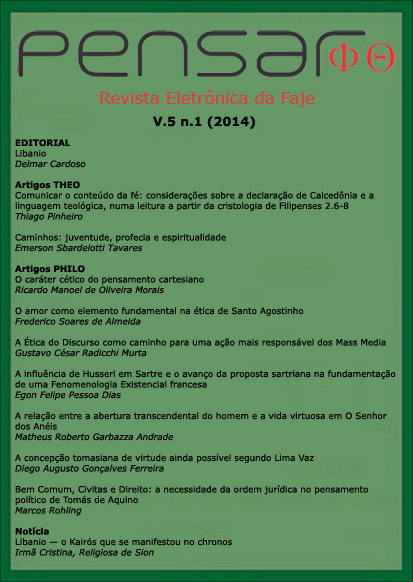COMUNICAR O CONTEÚDO DA FÉ
Palavras-chave:
Kenose, Calcedônia, Linguagem Religiosa.Resumo
Este trabalho caminha no intuito de realizar pelo menos três movimentos básicos: considerar questões relativas à linguagem e comunicação da fé, pensar a cristologia desenvolvida no concílio de Calcedônia (451) e lançar um olhar exegético sobre o hino cristológico da kenose em Filipenses 2:6-8. A partir desses três movimentos, verificar-se-á as distâncias e as aproximações entre o texto paulino e a declaração do quarto concílio ecumênico. Essa verdade afirmada nesses dois relatos aponta para a divindade e humanidade de Jesus. Em uma análise apriorística, notam-se preocupações e elementos próprios nas declarações bíblicas. A teologia pós-apostólica, por outro lado, possui suas próprias preocupações, o que suscita questões que levam a pensar na existência de um hiato entre a teologia dos concílios e aquela afirmada na Escritura. No entanto, pode-se dizer que existe uma distância significativa entre a teologia do primeiro século e aquela declarada em 451?, ou a igreja pode se assegurar do fato de a tradição se manter harmônica com o texto escriturístico através do Espírito que conduz a sua obra?Â
ABSTRACT:Â This work intends to perform at least three basic moves: to consider issues relating to the language and communication of faith, to think the Christology developed at the Council of Chalcedon (451) and launch an exegetical look at the Christological hymn of kenose present in Philippians 2:6-8. From these three movements, it will be investigated distances and similarities between the Pauline text and the declaration of the fourth ecumenical council. The truth affirmed in these two theological moments points to the divinity and humanity of Jesus. In an a priori analysis, it will be noticed some concerns and elements in the biblical statements. The post-apostolic theology, on the other hand, has its own concerns, from which raises questions that suggest the existence of a gap between theology developed in the councils and that affirmed in the Scripture. However, could it be said that there is a significant distance between the theology of the first century and that declared that in 451? Or can the church be assured of the fact that the tradition remains harmonious with the scriptural text through the Spirit who guides his work?





